
Tourism Places In ajmerThe tourist attractions in ajmer are the pilgrimage sites. ajmer is a popular pilgrimage center for the Hindus as well as Muslims. It houses the Dargah or tomb of the 13th century Sufi saint Khwaja Moinuddin Chisti, which is equally revered by the Hindus and Muslims.ajmer is also the base for visiting Pushkar, about 11 km. from ajmer, the abode of Lord Brahma, lying to its west with a temple and a picturesque lake. The Dargah of Khawaja Saheb or Khawaja Sharif is at the foot of a barren hill. The shrine is next only to Mecca and Medina for the Muslims of South Asia. It is said that Akbar used to make a pilgrimage to the Dargah from Agra once a year. The saint's tomb with a splendid marble dome is in the center of the second courtyard, which is surrounded by a silver platform. There is another mosque in the courtyard built by Shahjahan, the most marvelous of all the sanctums within the sanctuary of the Dargah.Adhai-din-ka-jhonpra is a remarkable structure, a masterpiece of Indo-Islamic architecture located on the outskirts, of the city, just beyond the Dargah. As the legend goes, its construction took two and a half days (Adhai-Din) to complete. It was originally a Sanskrit college, built within a temple. In 1193 A.D. Mohhamed Ghauri conquered ajmer and converted the building into a mosque by adding a seven arched wall in front of the pillared hall in just two-and-half days (adhai-din) and hence the name. ajmer also has a Jain Temple, Nasiyan Temple in red color built in 1865. The wooden gilt in the double storeyed hall exhibits images from the Jain mythology, describing the ancient Jain concepts. Lakes, Forts and Museums in ajmer. 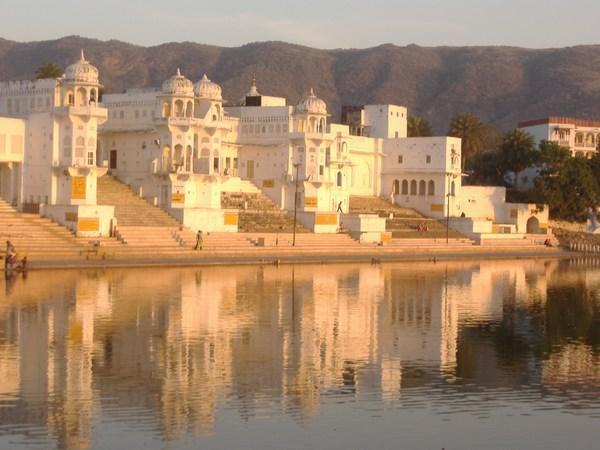 ajmer is blessed with lakes - Ana Sagar Lake, built between 1135-1150 AD by damming the river Luni. This artificial lake is bounded by hills and on its bank is a beautiful park - the Dault Bagh, making this place one fine spot for strolling in the morning and evening. Foy Sagar is just 5 kms from the town and 3 kms further up the valley from Ana Sagar Lake. Built during a famine relief programme it is named after the engineer responsible for its construction, the picturesque lake offers spectacular views form the hill. ajmer has a fort, Taragarh Fort, a steep one and a half hour climb beyond the Adhai-din-ka-jhopra, which leads to the ruins of the Taragarh Fort, perched on a hill. One can have an excellent view of the city from here. The fort was the site of the military activity during the Mughal period, later used as a sanatorium by the British Constructed by Akbar in 1570, the Royal palace of Akbar in red sandstone was converted into a Government Museum and today it houses a rich collection of Mughal and Rajput armory. Very close to the main post office, the museum displays some of the fine and delicate sculptures of the region, from 8th century AD, which include - old weapons, miniature paintings, ancient rock inscriptions and stone sculptures. Festivals of ajmer 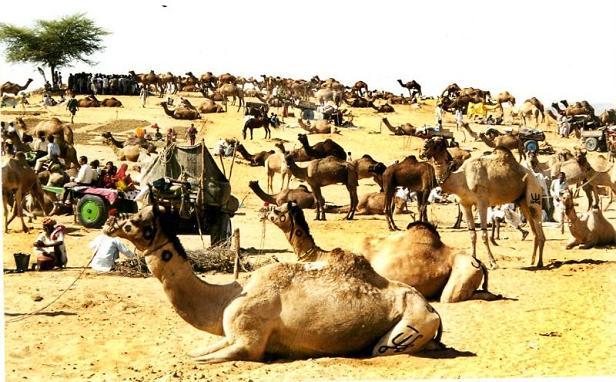 One can make excursions from ajmer to the neighboring town of Pushkar known for the annual Pushkar Fair. Pushkar becomes a bustling and colorful fairground in the month of Kartik (October-November) when the annual Pushkar Fair is held. Hindu pilgrims come for the holy dip in Pushkar Lake, which is considered most on Kartik Poornima.The highlight of the fair is the Camel Fair, the trading of camels. Camels are bought, sold, decked up and paraded on the sand dunes, presenting a picturesque sight. The camel, horse and donkey races are events that draw huge attendance. The Pushkar Fair also brings together a large number of villagers from different parts of the state who display their traditional ware and also making the evenings colorful and festive with music and dance. There are about 400 temples in Pushkar famous as a spiritual tourist attraction, of which the most famous is the Jagat Pita Shri Brahma Mandir.It is said to be the only temple in the world dedicated to Brahma. Then there is the Savitri Temple overlooking the Pushkar Lake, the Varah temple, the Mahadeva Temple and the Ramvaikunth Temple. There are many ghats, which run down to the Holy Pushkar Lake whose waters are famed to wash the sins of a lifetime. Other places of interest around ajmer are Mangliyawas, 26kms from ajmer is famous for two 800 years old trees of a rare species, popularly known as 'Kalpa-Vriksha'. People visit this place through out the year but on dark moon day of 'Sravana' (also spelt as Shravana) thousands of people come to worship the trees. Beawar, 54kms from ajmer is famous for the Badshahi procession festival held on the next day of Holi when people participate in large numbers and throw 'Gulal' on each other. Kishangarh, 27kms from ajmer has one of the finest schools for miniature paintings during 18th century. Badnor, 80kms from ajmer is best known for its 500 years old imposing fort. Pachewar, 90kms from ajmer is a small village in Rajasthan, which is an ideal stopover for the tourists traveling between ajmer and Jaipur. The lake at Pachewar attracts thousands of migratory birds in the winters, a sight mostly loved by tourists. Fairs and Festivals The major tourist attraction in Pushkar is definitely the annual Pushkar Fair, which attracts tourists annually to this small sleep, lakeside town. Pushkar is a sacred town for the Hindu and is situated about 11kms northwest of ajmer. Pushkar finds mention in the Epics and Kalidasa'a Sakuntalam. There are about 400 temples in Pushkar famous as a spiritual tourist attraction, of which the most famous is the Jagat Pita Shri Brahma Mandir.It is said to be the only temple in the world dedicated to Brahma. Then there is the Savitri Temple overlooking the Pushkar Lake, the Varah temple, the Mahadeva Temple and the Ramvaikunth Temple. There are many ghats, which run down to the Holy Pushkar Lake whose waters are famed to wash the sins of a lifetime. Pushkar becomes a bustling and colorful fairground in the month of Kartik (October-November) when the annual Pushkar Fair is held. Hindu pilgrims come for the holy dip in Pushkar Lake, which is considered most on Kartik Poornima.The highlight of the fair is the Camel Fair, the trading of camels. Camels are bought, sold, decked up and paraded on the sand dunes, presenting a picturesque sight. The camel, horse and donkey races are events that are hugely popular with the tourists. The Pushkar Fair has become a major cultural event in the state of Rajasthan bringing together a large number of villagers from different parts of the state of Rajasthan who display their traditional ware and also make the evenings colorful and festive with music and dance. BRAHMA TEMPLE : 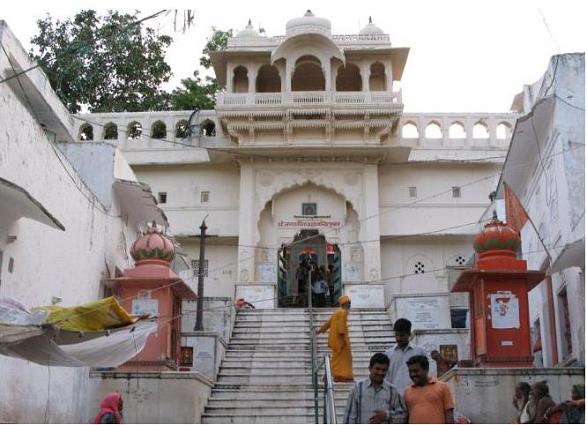 Although the city of Pushkar ahs 400 odd temples, the Brahma Temple is the most famous of them. Brahma is one of the Hindu trinity Brahma, Vishnu and Maheswar - the three gods representing creation, sustenance and destruction. According to the myths, Brahma is the god of creation of this earth. The four heads symbolizes His presence everywhere. The most remarkable thing about the Brahma temple is that it is the only one temple on earth dedicated to Lord Brahma. Pushkar literally means a pond created by flowers. Legends have it that Lord Brahma, when wanted to perform a yagna, dropped a lotus to determine the place on earth. That is how Pushkar was created. There is more to this story. Lord Brahma wanted to perform the ritual at the most auspicious time but it required the presence of His consort Savitri. Irritated by her delay, He married Gayatri the milkmaid and installed her instead of Savitri. Savitri got infuriated by this and cursed that no one on earth would worship Him. Later relented on pleas from other deities, she agreed that Lord Brahma would only be worshipped in Pushkar. According to the ancient scriptures, this is one of the most sacred pilgrimage sites for the Hindus. The temple stands on a high pedestal with marble stairs leading up to this. The temple houses a life-sized idol of the 4-headed God. Silver coins ate embedded on the black and white chequered marble flooring. A beautifully carved silver turtle is placed on the floor facing the sanctorum SAVITRI TEMPLE 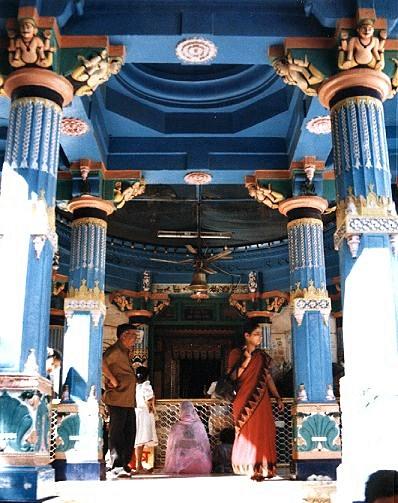 Savitri Temple in one of the most renowned one out of 400 temples in Pushkar. According to the Hindu mythology Savitri is the first wife of Lord Brahma. When He was all set to start a Yagna on earth in the place of Pushkar (determined by drooping a lotus flower), Savitri's presence was the prerequisite. But She had kept Him waiting. Lord Brahma, irritated at this, married Gayatri the milkmaid to start the yagna on the most auspicious moment. Infuriated Savitri cursed that Lord Brahma would not be worshipped anywhere else but Pushkar. Hence you find the only temple dedicated to Lord Brahma only inn Pushkar. Perched on a hillock, Savitri Temple stands just behind the temple of Lord Brahma. A long series of steps lead to the shrine. From the temple you can get a panoramic view of the Pushkar lake, the surrounding temples and the sand dunes. Apart from enjoying adventure filled tours to the Kishangarh Fort, Adhai Din Ka Jhonpra, Nasiyan Jain Temple, Akbar's Palace and the celebrated Dargah of Hazrat Moinuddin Hasan Chisti you can set out on fascinating tours to several other tourist attractions that add to the rustic glamour of ethereal ajmer with Rajasthan Holiday. Tour the captivating Jhulelal Temple on your tours to Rathore ajmer with Rajasthan Holiday. Marvel at the captivating rituals that are performed to impress the main deity, Sheetla Devi. Also see the enchanting tourist attractions located near Mangliyawas. Taragarh Fort : 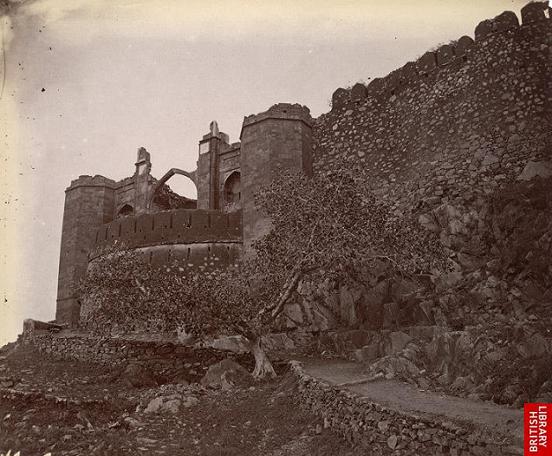 Taragarh Fort Tour the imperial Taragarh Fort and explore the regal secrets of this remarkable structure in stone located atop the Nagpahari hill in ajmer with Indian Horizons. Constructed in 1354 A.D., the Taragarh Fort in ajmer is a spectacular illustration of Rajasthani architecture. Six imposing gates and a thick crenellated wall guard the entrance to this erstwhile Chauhan bastion. You are welcome to explore the royal secrets of Taragarh though a section of this massive structure is not open for public viewing. See the awe-inspiring Bhim Burj i.e. a massive battlement on which rests a large canon and admire the huge stone water reservoirs built within the fort. The main gateway that leads you to the fort is decorated with stone sculptures of elephants. Pay homage at Miran Saheb ki Dargah that is located within the fort walls. This mausoleum is dedicated to Miran Saheb, a brave warrior who sacrificed his life defending Taragarh in an enemy invasion. Taragarh Fort was an important center of military activity during the Mughal domination in ajmer. Later during the British occupation of ajmer, Taragarh was used as a sanatorium. Enjoy a spectacular view of the city below from the Taragarh Fort and drink in beautiful vistas of ajmer steeped in the warmth of the last rays of the setting sun. Also tour the interesting Dudha Mahal located at a little distance from the Taragarh Fort. Taragarh or the 'Star Fort' is situated three kilometers and a steep 1 and a half hour climb beyond the Adhai-Din-Ka-Jhonpra Mosque. As it is situated on a height, it commands a spectacular view over the city. It was built by Ajaipal Chauhan, the town's founder. The fort was the site of much military activities during Mughal times and was later used as a sanatorium by the British. Shahjahan's Mosque About Shahjahan's Mosque In the corner of the inner court of the Dargah, is a magnificent building in white marble with a long (30.5m) and narrow court having low arcade and delicate carvings with trelliswork it is the most marvelous of all the sanctums within the sanctuary of the Dargah. Pushkar Lake : 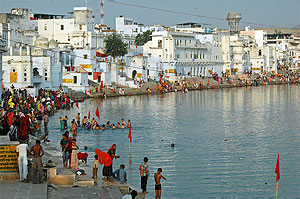 Pushkar lake is situated at the edge of the desert and surrounded by the hills from three sides. This lake get apart from ajmer by the snake mountain range called locally as ' Nag Parvat'. According to the legend Pushkar was originated when lord Bhramha was looking for a peaceful place for 'Yagya'. It is said that a Lotus flower slipped from his hand and fell down on this hill, where the Pushkar Lake derived. Therefore the Bhramha temple situated here, is a famous pilgrimage for Hindus. On this mountain, the Panchkund and the cave of the saint Agastya are located. Mayo College 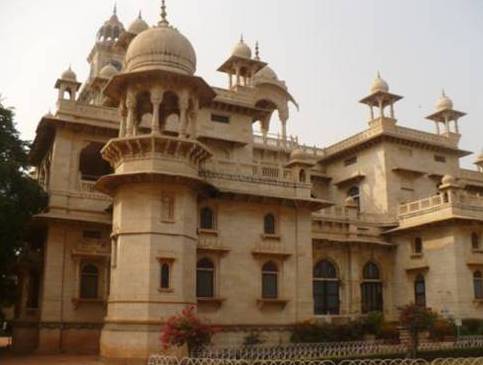 Mayo College is a school that was designed to make British gentlemen out of Indian princes. Years after its first student, Maharaja Mangal Singh of Alwar, rode into the campus on an elephant in 1875, Mayo College in ajmer still retains the quality to attract the creme de la creme of India. Today however, the school is not looking for princes to turn into Englishmen. It seeks to impart excellence in academics as well as sports to boys with potential. Man Mahal Man Mahal Along the banks of the Pushkar Lake is the former residence of Raja Man Singh of Amer, Man Mahal. Presently it is converted to RTDC Sarover Tourist Bungalow ensuring convenient accommodation to travellers. Pushkar palace ( Kishangarh House) adjoining it is a heritage hotel. Foy Sagar Foy Sagar is a picturesque artificial lake named after the engineer for who created it under a famine relief project. Dargah Sharif Dargah Sharif Situated at the foot of a hill and in the old part of town, this is one of the most important places in india for muslim pilgrims. The Dargah is the tomb of a Suffi saint, Khwaja Muin-ud-din Chishti, who came to ajmer from Persia in 1192 and died here in 1236. Construction of this shrine was completed by Humayun and the gate was added by the Nizam of Hyderabad. Akhbar used to make the pilgrimage to the Dargah from Agra once a year. As you enter the courtyard, the mosque, constructed by Akhbar, is on the right. The enormous cauldrons are for offerings that are customarily shared by families involved in the shrine's upkeep. In the inner court there is another mosque built by Shah Jahan. Constructed of white marble, it has 11 arches and a Persian inscription running the full length of the building. The saint's tomb is in the center of the second court. It has a marble dome and actual tomb inside is surrounded by a silver platform. The horse shoes nail to the shrine doors are offerings from successful horse dealers. Ana Sagar Lake 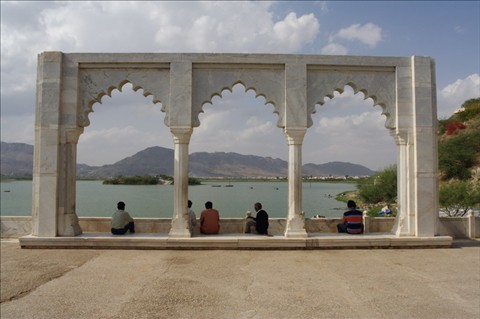 Ana Sagar
This artificial lake was created by damming the river Luni.On its bank are the fine parks, the Dault Bagh and Subhash Bagh, with a series of marble pavilions that were erected in 1637 by Emperor Shah Jahan. There is an island in the center of the lake which is accessible by boats or water scooter. Boats and water scooters could be hired from the east side of the Dault Bagh. It is a famous place for evening stroll.
Ana Sagar
This artificial lake was created by damming the river Luni.On its bank are the fine parks, the Dault Bagh and Subhash Bagh, with a series of marble pavilions that were erected in 1637 by Emperor Shah Jahan. There is an island in the center of the lake which is accessible by boats or water scooter. Boats and water scooters could be hired from the east side of the Dault Bagh. It is a famous place for evening stroll.Time : 10 AM - 4:30 PM (Saturday-Thursday). Dargah of Hazrat Khwaja Moinuddin Chisti : 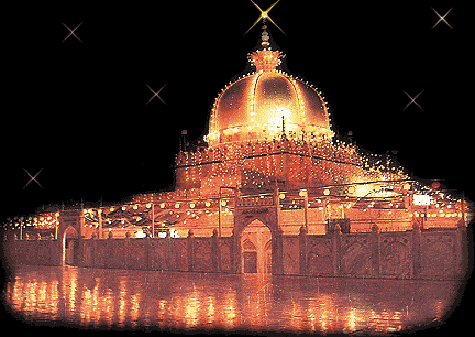 The Dargah of Hazrat Khwaja Moinuddin Chisti with Indian Horizons and discover a pious mausoleum where you find peace and happiness.
Hazrat Khwaja Moinuddin Chisti was born and brought up in Persia. He lost his parents at the age of 16 and inherited an orchard and other family businesses that he renounced after he met a pir baba who stopped by on his orchard one day.
The Dargah of Hazrat Khwaja Moinuddin Chisti with Indian Horizons and discover a pious mausoleum where you find peace and happiness.
Hazrat Khwaja Moinuddin Chisti was born and brought up in Persia. He lost his parents at the age of 16 and inherited an orchard and other family businesses that he renounced after he met a pir baba who stopped by on his orchard one day.
Hazrat Khwaja Moinuddin Chisti was a great Sufi saint who was the harbinger of Islam in India. He served and blessed the poor. It is believed that those who come and pray with unadulterated faith and devotion at his Dargah or mausoleum are blessed out of their miseries. The holy Dargah Sharief in ajmer is the second most important pilgrimage after Mecca and Medina for the Muslims all over the world. The magnificent gateway that leads to the Dargah was constructed by the Nizam of Hyderabad. Invoke the blessings of almighty Allah at the two mosques located within the Dargah Sharief in ajmer, Rajasthan, India. Sprawled over a huge area in the heart of ajmer, the Dargah of Hazrat Khwaja Moinuddin Chisti is located at a distance of 4 kilometers from the ajmer railway station. Marvel at the aesthetic and stunning white dome that crowns the main tomb. Besides Hazrat Khwaja Moinuddin Chisti's Dargah there are several other monuments of historic interest located within the Dargah Sharief enclosure. Tour the tenement of Bibi Hafiz Mahal, Begami Dalan that was constructed in the memory of Begum Jahanara, See the Mehfil Khana, Aulia Mosque and the Chillah of Baba Farid. Adhai Din Ka Jhonpra : 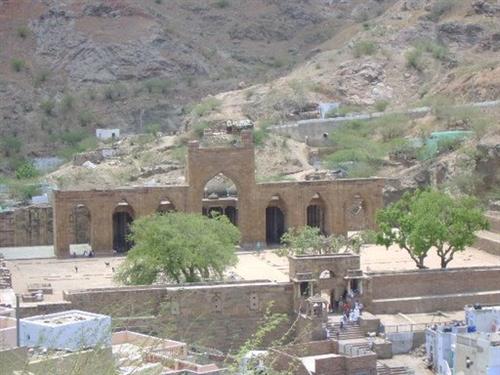 Adhai Din Ka Jhonpra Beyond the Dargah, on the outskirts of town, are the ruins of Adhai-Din-Ka-Jhonpra mosque. According to legend its construction, in 1153, took just 2 and a 1/2 days. (Adhai-Din-Ka-Jhonpra means '2 and a 1/2 day building'). Others believe it was named after a festival that lasted for 2 and a 1/2 days . It was originally built as a Sanskrit college , but in 1198 Mohammed of Ghori took ajmer and converted the building into a mosque by adding a seven-arched wall covered with Islamic calligraphy in front of the pillared hall. 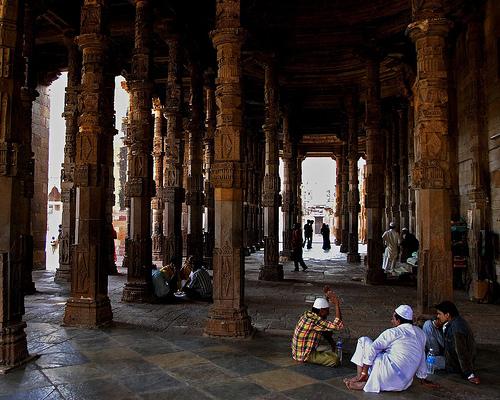 Tour the stunning Adhai Din ka Jhonpra on your tours to ajmer tourist attractions with Indian Horizons. This spectacular piece of architecture gets its name from the fact that it was constructed within a period of 2 and a half days. Adhai Din Ka Jhonpra exhibits an exquisite blend of Indo-Islamic architectural styles. Interestingly enough the main edifice of this mosque was a center of Sanskrit education in the olden days and the pillars of the mosque that were reassembled with architectural finesse to construct this grand mosque were taken from destroyed Hindu and Jain temples in the area. Tour the Adhai Din Ka Jhonpra with Indian Horizons and read Koranic versus chiseled on the 7-arched wall inside the mosque. The Mosque was designed in a hurry by a Persian architect, Abu Bakr who did a remarkable job of creating this beautiful mosque. The main pillared hall and yellow limestone arches on the fa�ade of the main entrance create quite an impact. There is a beautiful tower inside the mosque that is used by the Muezzin to chant prayers. The stone walls of the main prayer hall are chiseled into a net like appearance with carved rectangular panels on them. The idea was to create a natural lighting effect that was common in the mosques of Persia. Though the walls of Adhai Din Ka Jhonpra are adorned with phrases and quotes from the holy Koran, there is a tiny Sanskrit inscription right on top of the main gate that reminds you of the actual origin of this historic monument constructed by Mohammed Ghori in 1198 A. D. Nasiyan Jain Temple 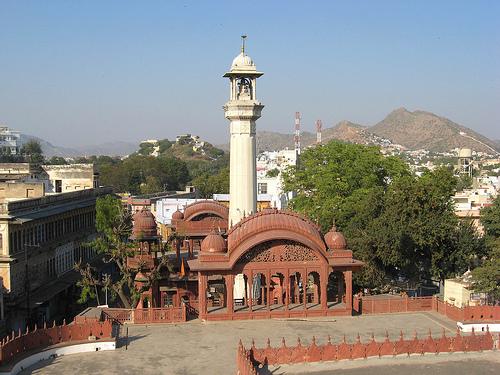 Nasiyan Jain Temple Situated in the center of the town is a beautiful red Jain temple (Digambar), known as Nasiyan. This temple was built in 1865 and is also famous by the name Golden Temple, due to tis amazing and unique display. The main double storeyed hall is exceptionally beautiful with gold and silver decorations. Within the temple there is a splendid display of wooden gilt representations, glass engravings and paintings describing the Jain faith about the creation of the world. General Tips: Remove your shoes before entering the Temple. Tour the Nasiyan Jain temple located on the Prithvi Raj Marg in ajmer in Rajasthan, India. Also known as the Red Temple, Nasiyan Jain Temple mesmerizes you with its historic appeal. Dedicated to the first Jain Tirthankara Rishabdeoji, the Nasiyan Jain Temple also has a museum of considerable size that displays objects related to Jain beliefs and mythology. Enjoy the delightfully sculpted motifs that adorn the walls of this Digambar Jain temple in ajmer, Rajasthan, India. Constructed in 1865, the main chamber of the Nasiyan Jain Temple consists of a splendid 2-storied hall adorned with wood carved sculptures that depict the Jain concept of the world and worldly affairs. The first floor of the Nasiyan Jain Temple is known as the 'Swarna Nagri' and displays gold plated replicas of almost all the Jain temples in India. Be enchanted with the little silver balls that are suspended from the ceiling in the inner sanctum of the Red Temple in ajmer, Rajasthan, India. The interiors of the Digambar Jain Temple or the Nasiyan Jain Temple are decorated with gold, silver, precious stones and semi-precious gems. The wooden gilt decorations and delicate paintings that adorn the main hall of the temple display scenes from episodes in Jain mythology and preach Jain beliefs regarding life and the world. Other Tourist Attractions Tour the impressive monumental magnificence of ajmer with Indian Horizons. See the intimidating Taragarh Fort perched atop the Nagpahari and tour historic monuments like Akbar's Palace, Kishangarh Fort, Adhai Din Ka Jhonpra and Nasiyan Temple on your tours to ajmer tourist attractions. Besides the above mentioned there are several other tourist attractions located all over ajmer that definitely warrant a visit. Each of these tourist attractions is a repository of history and ethnicity and reflects the cultural traditions of this holy land graced with the Dargah of Hazrat Khwaja Moinuddin Chisti or Garib Nawaz. The simple and aesthetic Abdullah Khan's Tomb is a visual treat. Also see Abdullah Khan's wife's tomb that is located in the same compound. Tour the picture pretty Ana Sagar Lake that came into existence when a dam was constructed across River Luni. Relax in the midst of Daulat Bagh lawns on the banks of the Ana Sagar Lake and admire the artistically carved marble baradaris that adorn the pleasing Daulat Bagh greens. Visit the Khobra Behroon Temple located near the Ana Sagar. According to local legend it is very important for newly wed couples to pay their respects at this temple. Tour the Solahkhamba or the 16-pillared tomb of Sheikh Ala-al-Din, who was the main overseer of Hazrat Khwaja Chisti's Dargah. In fact the Solahkhamba is located just outside the Dargah and was constructed by Ala-Al-Din himself just before he passed away. Located at a 2-hour drive from the main ajmer city, the Badnor Fort is an enchanting medieval fort that is located in the Bhilwara district of Rajasthan, India. Also tour the Sawai Bhoj Temple located close to the fort on your excursion tours from ajmer with Indian Horizons. Also tour the Mahadev Mandir, Mayo College, Jhulelal Mandir, Shah Jahan's Mosque, Mangliyawas and the Man Mahal on your tours to ajmer tourist attractions with Indian Horizons. Akbar Palace Akbar's Palace is the Back in the city, near the railway station, this fort was built by Akbar in 1570 and today houses the ajmer Museum. Exhibits in limited collection of this museum include old weapons , miniature paintings, ancient rock inscriptions and stone sculptures that date back to the 8 th century AD. 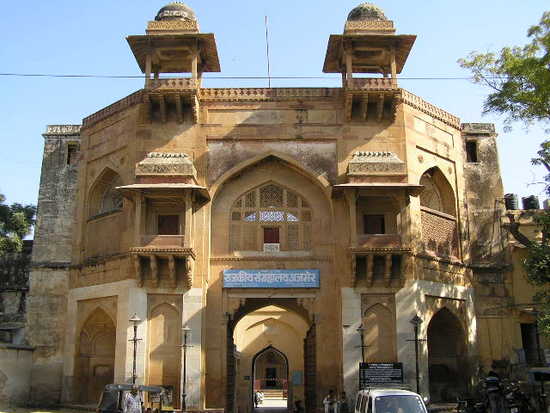 Akbar's Palace See splendid remnants of the grandiose Mughal rule in ajmer as you tour the rooms and sections of Akbar's Palace or the ajmer Museum with Indian Horizons. Akbar's Palace is located close to the railway station in ajmer and is a grand way to learn more about the romantic yet tumultuous history of desert ajmer. See ancient and medieval weapons and armory on display and gaze wonder eyed at a glorious collection of stone sculptures, objects d' art and delicate miniature paintings. See the choicest collection of Rajput and Mughal armor on display at the Akbar's Palace. Constructed in 1570 A.D. by Emperor Akbar, Akbar's Palace was built for serving as a home to the emperor during his visits to ajmer. Though not very massive, Akbar's Palace was almost impregnable to enemy attacks. The two thick walls that surround Akbar's Palace are formidable structures. Akbar's Palaces' historic importance lies in the fact that this fortified Mughal bastion served as a platform for a historic meeting between Emperor Jehangir and Sir Thomas Roe of the British East India Company. During the British occupation of ajmer, Akbar's Palace was used as a munitions house and the Britishers nicknamed this palace as the 'Rajputana Arsenal'. A part of Akbar's Palace was converted into a museum in the year 1908. Be charmed at the massive black marble idol of the Goddess Kali. Also feast your eyes on several 6th and 7th century sculptures as you tour the Akbar's Palace in ajmer, Rajasthan, India. Kishangarh Fort 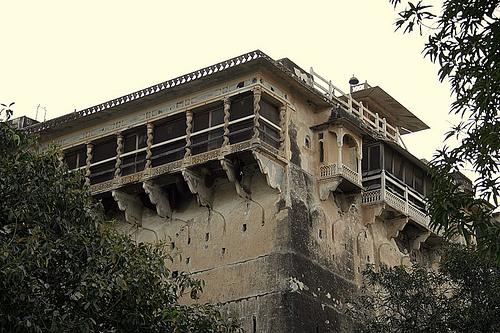 Fortified by a massive moated wall, the Kishangarh Fort presents a formidable yet enchanting picture. Tour the interiors of this grand fortress and let the old fort walls remind you of a glorious era of successful Rathore rule. The imposing Kishangarh Fort was constructed in 1653 by a Rathore King, Maharaja Roop Singh. As legend goes Maharaja Roop Singhji drew inspiration from an incident where he saw a sheep defending her lambs from a pack of wolves. The Fort at Kishangarh remained unconquered inspite of constant enemy attacks. The magnificent Kishangarh Fort entices you with its historic palaces and monuments. Located close to ajmer, the Kishangarh Fort is located at a distance of 27 kilometers from the main ajmer city. Also see the splendid Phool Mahal that is located near the Kishangarh Fort as you tour the tourist attractions of ajmer, Rajasthan, India. Feast your eyes on stunning vistas created by the vast lake located near the majestic Kishangarh Fort in ajmer. Spot rare birds that flock near the lake. The Kishangarh Fort was the main center from where the rulers patronized the Kishangarh school of miniature paintings. In fact initially it was Maharaja Sawant Singhji and his beloved Bani Thani who modeled as Lord Krishna and Radha for the court painters. Excursions from ajmer Excursions from ajmer with Indian Horizons give you an opportunity to explore glorious Rajasthan monuments, ruins and shrines that adorn the land of the brave and chivalrous. Tour the monumental splendor of Kishangarh on your excursions from ajmer. Located at a distance of 27 kilometers from the ajmer city, Kishangarh is famous for being the birthplace of the 'Kishangarh School of Miniature Paintings'. This delicate and vibrant art form flourished under the patronage of the local rulers. Raja Sawant Singh and his endeared lover, Bani Thani are known to have modeled as Lord Krishna and Radha for the court painters in different positions. Tour the grand Kishangarh Fort that reflects volumes about the architectural glory of those times. Drive to the Roopangarh Fort and explore its historic corridors. Picnic at the lovely Foy Sagar Lake that is located at a distance of 5 kilometers from ajmer. Foy Sagar was designed and dug under the supervision of an English architect as a part of a famine relief project. Located at a distance of 54 kilometers from ajmer, Beawar is an interesting tourist place to enjoy excursions to. Beawar is known for the bright annual Holi procession that is a colorful expression of the true Rajasthan festive spirit. Excursions to Mangliyawas with Indian Horizons show you a delightful world steeped in old-world charm. There are two 800-year old trees in Mangliyawas that are considered as sacred by the local and are said to be of religious and historic importance. Enjoy excursions to Pushkar that is located at a few hours drive from the ajmer City and see its sacred Ghats and ancient Hindu temples. Drive to Tilonia and see its local attractions. |

